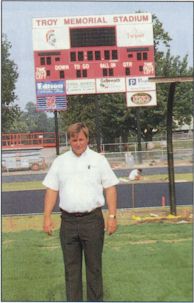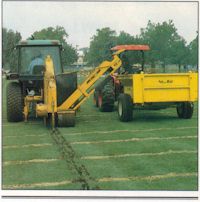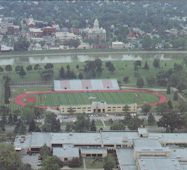|
Sports Turf Magazine - Article
|
Reprint from
Sports Turf Magazine, Nov/Dec 1994
|
|

|

|

Installation of the sand-conduit drainage system, July
1994.
|
|
|
|

|
| (Top) Ted
Mercer of Ever-Green Lawn Care
stands in front of the new scoreboard, which like the field, came from
donations. |
| (Left) Troy Memorial Stadium serves as the
center of a 20,000-population community in southern Ohio. |
Troy Memorial
Stadium Gets a Lot of Help From Its Friends
|
By Bob Tracinski
 roy, OH, is a town of just
under 20,000 people, nestled 20 miles from Dayton and 70 miles from
Cincinnati and Columbus. It has 189 acres of parkland and an 18-hole
public golf course. Jogging and biking trails are just a few of the
perks that attest to the community's interest in sports. The town's
centerpiece is 10,000 seat Troy Memorial Stadium, a combination
football/soccer facility that shows what Small-Town America can
accomplish when the whole community pulls together. roy, OH, is a town of just
under 20,000 people, nestled 20 miles from Dayton and 70 miles from
Cincinnati and Columbus. It has 189 acres of parkland and an 18-hole
public golf course. Jogging and biking trails are just a few of the
perks that attest to the community's interest in sports. The town's
centerpiece is 10,000 seat Troy Memorial Stadium, a combination
football/soccer facility that shows what Small-Town America can
accomplish when the whole community pulls together.
Troy's original, 10,000-seat stadium was built
in 1949. The old cinder track circling the football field was replaced
with an all-weather track in 1976. The manual irrigation system was
updated in 1985 to an 11-head, automatic irrigation system. Troy
Memorial Stadium is city owned, but used by the school system, which is
in charge of maintenance. And the native-soil field, reserved for
varsity-level competition and selected special events, looked good and
held up well.
But soccer had come to Troy. Junior high and
high school boy's and girl's teams deserved the opportunity to play
their key games
|
in the town's showplace arena. Troy Field had a maximum
playable width of 160 feet and a 26-inch crown, far from ideal for
soccer.
The track had deteriorated. Changes in
competition standards made its existing 440-yard length and eight
36-inch wide lanes outdated. Lighting was inadequate for both the
participants and the spectators. Space was insufficient to increase
field and track size within existing dimensions.
For Troy Memorial Stadium, it was time for a
lot of help from its friends.
Athletic Director Tom Mercer, Supervisor of
Facilities Jim Kaster and School Treasurer Don Pence formed the
core of the Troy Memorial Stadium Renovation Project planning committee.
They asked for input from coaches, other field
users and the maintenance team. They dug deeply for details. For
example, Kevin Jacobs, a member of the maintenance staff specializing in
grounds maintenance, said, "They asked me and my crews how we were
currently handling the field-striping and lining procedures.
With the renovation, a designated |
paint-refilling area is set aside, hidden from
public view, with EPA-approved drainage and trapping systems. The same
level of investigation and planning went into every aspect of the
project."
They called on the expertise
of two of the town's leading engineers, the retired Henry Iglesias and
Richard Klockner of Klockner & Associates. Klockner worked on the
surveying crew of the original field and, with grandchildren in the
school system, had a more than passing interest in the field. These two
men generously volunteered their services -- and sparked an innovative
idea.
Community Spirit
and Private Donations
By the time the three-phase,
$1.3 million renovation plan was completed, so was the resolve to raise
the funds from donations within the community -- with no help from city
funds or tax dollars.
(Continued below...)
|
|
 |
Don Pence and Tom
Mercer teamed up to coordinate the project and fund-raising, launching
efforts in April 1993. Sept. 2, 1994, was the targeted completion date
for Phases I and II -- requiring $1.1 million in funds. Phase III,
calling for $200,000 in improvements to Fergusen Field, located near
Troy Junior High, is scheduled for 1995.
Phase I, which was the installation of new
poles, lights and an upgrade of electrical service, was completed in
time for the 1993 homecoming football game. The cost for this phase was
$190,000.
Phase II was more complex, with $910,000 needed
to move the south stands back 40 feet to allow for a regulation-size
running track, install a new storm-and sanitary sewer system, enlarge
and upgrade the restrooms and concession areas, construct a press box on
the south stands, remodel the press box on the north stands, replace the
scoreboard, recap stadium seating, repaint the decking, spruce up the
ticket and entrance areas, install additional paving and rebuild the
field to accommodate both football and soccer.
Field renovation alone called for regrading and
widening the playing surface to meet standards for soccer, increasing
out-of-bounds areas to provide better safety for participants,
improving soil composition, planting new athletic turf, and installing
new irrigation and drainage systems.
With one year and three months to raise more
than $1 million from a population base just under 20,000, the odds were
darn good.
This is Troy, where community spirit soars. The
original stadium was part of a 1947 bond issue, proposed by Edward A.
Hobart, president of Hobart Bros. Co., which called for a comprehensive
sports expansion program -- a new golf course, bridge and the stadium --
at a cost of $450,000. The stadium was to serve as a memorial to those
who fought and died for their country. If the town passed the bond
issue, the plan called for the C. C. Hobart Foundation to donate a
winter sports building, Hobart Arena, to the city. A special election
was held March 4, 1947. The issue passed with a whopping 88.3 percent
"yes" vote.
None of that community spirit was lost in the '90s.
Ted Mercer (Tom's brother) is general manager of Ever-Green Sports Turf,
a division of Troy's Evergreen Lawn Care Inc., the general contractor
for the playing field reconstruction. According to Mercer,
"Although the fund-raising project was intensive, it wasn't really
hard a sell. The stadium is a landmark of this community and with the
private donor setup, if you didn't like the idea, you didn't need to
give anything. There were few negative comments and little criticism.
The city of Troy, Troy City Council, the park board and Troy Chamber of
Commerce were behind the effort 100 percent. All the local media -- Troy
Daily News, Troy Advocate, WTRJ radio, WPTW/WCLR radio and WHIO-TV
-- gave their support with continuing coverage, public service
announcements and other assistance."
As Mercer and
Pence, along with a dedicated group of volunteers, put out a mail blitz
to local residents and alumni of Troy High School, and hit the luncheon
meeting circuit to raise funds, they were prepared with a full layout of
the proposed renovations and a far-reaching commemorative gift and
incentive program with perks for each plateau. Because this was truly a
grassroots efforts, donation requests started at a dollar.
For a $1-$49 donation, the donor received
acknowledgement and a deed of the gift; at $50-$499, along with the
acknowledgement and deed, the donor's name would be listed on a stadium
entrance plaque; a $500-$999 donation was recognized with a name listing
on the Letterman's Club Plaque under the home stands; and for
$1,00-$2,499, the donor's second listing moved "up" to the
Varsity Club Plaque under the home stands. Donors also received a signed
and numbered print depicting Troy Memorial Stadium; at $2,500-$4,999,
the second listing moved to the Scarlet and Gray Club Plaque under the
home stands and the stadium print would be matted and ready for framing;
and at the level of $5,000 and more, the second listing was on the
Trojan Club Plaque under the home stands and the print would be
professionally matted and framed for the donor.
Small rewards? Perhaps, but highly significant within the
community.
Who chipped in? Hundreds of Troy
citizens. Troy High School alumni from across the country, business and
industry, service clubs, fraternal orders, booster organizations,
parent-teacher organizations, student groups and local foundations.
Several donors were singled out for special
thanks, including Boyer Trust, Mt. and Mrs. Robert Bravo, The C.C.
Hobart Foundation, the city of Troy, Dayton Power and Light, the Paul G.
Duke Foundation, Earhart Petroleum, Richard W. Klockner &
Associates, Robert B. Meeker, Dr. and Mrs. Walter Meeker, PMI Food
Equipment Group, Peoples Savings Bank of Troy, Thom and Pat Robinson,
Star Bank, Stillwater Technologies, Trojan All-Sports Booster Club, the
Troy Foundation and one anonymous donor. The single largest contribution
was $250.000.
In addition, in-kind donations of time,
labor and materials were received from local professionals and
contractors. In fact, with actual costs for Phase I and II running at
$1.22 million, only $19,000 -- less than 2 percent -- was spent for
"professional fee."
Just how extensive was that renovation? In a
crowd-pleasing show, with one 200-ton crane at the front and one 250-ton
crane at the back, three sections of the iron and steel stadium south
wall and stands were moved 40 feet to the south. This opened space for
installation of the new 400-meter, all-weather track with eight
42-inch-wide lanes. Always looking to the future, |
renovation planners
made sure this track also will accommodate an AAU-sanctioned
steeplechase.
Then field renovation began. Ever-Green Sports
Turf was selected as the general contractor because of its
athletic-field building and renovation experience and its familiarity
with the field. All of the fields used by the Troy schools are under a
maintenance contract with the firm. For the Memorial Stadium field, the
company handles all maintenance procedures and mowing. The other fields
are mowed by school personnel. The firm's maintenance services are
contracted at various levels by many area school districts to ptovide
the expertise of sports-turf professionals --and Sports Turf Managers
Association (STMA) members -- on a regular basis.
Mercer said, "Drs. John Street and Bill
Pound, both of Ohio State University, assisted with the development of
field specifications and layout. The existing media was 36-percent sand,
42-percent silt and 22-percent clay, a mixture we call 'black was'
because of its poor drainage characteristics. We stripped away the top
12 inches. Crews from Hydroscapes Inc. of Dayton then updated the
irrigation system. It was placed 20 inches below the original soil
surface. They also installed a bank of 49 heads. This provides a shorter
"throw" than the previous system and more effective
irrigation.
"It took 65 tandem loads to deliver
the 1,000 tons of sand necessary to work into the remaining media to
bring the field to the 62-percent sand, 18-percent silt and 20-percent
clay-soil profile that we wanted. CLC Labs of Westerville, OH, did the
media testing for us. The reworked field is 360 feet long, 180 feet
wide, and has a 15-inch crown.
"On May 13, we seeded with Medalist
America's Athletic ProR blend of 50-percent Kentucky bluegrass and
50-percent perennial ryegrass at a rate of 225 pounds per acre. Because
of the high sand content of the soil, we spread the seed with a Brillion
spreader, rather than drill seeding.
"Initially, we applied am 8-32-16
fertilizer weekly. Once we reached the phosphorus levels we wanted, we
switched to a 30-3-5 formula with 25-percent slow-release nitrogen. We
mowed for the first time in June 7. Weed problems were, and have been
minimal. We've spot-treated where necessary, with no need for a blanket
weed control.
"By July 5, we had a full stand of turf.
We held a field day, invited those from the university and business
firms who had assisted with the project, selected seed and sod company
personnel and the local media. Then we shocked them by cutting up the
field."
Joe Motz and his crews from Motz Sports Turf in
Cincinnati started installation of a sand-conduit drainage system.
Slits, 2 inches wide and 14 inches deep, were cut from sideline to
sideline, spaced every 6 feet. Tubing, with a 2-inch outside diameter,
was placed at the base of these slits and covered with a 4-inch layer of
pea gravel. The tubing leads to 6-inch corrugated piping placed at a
14-inch depth around the perimeter of the field. The pea-gravel layer is
covered with an 8-inch layer of sand. Next, slits, 1 inch wide and 8
inches deep, were cut across the length of the field on 3-foot centers.
These slits were filled with sand. The field was then topdressed with an
additional 80 tons of sand. Installation was completed July 15, leaving
the field with a temporarily apparent grid pattern."
Renovations continued on the rest of the
stadium as well. The new restrooms and concession area were constructed.
The sewer system was installed. The press box on the home-team side of
the stands was renovated. (The pressbox on the visiting team side is
still "in the works.")
A $150,000 scoreboard, with four color
graphics, was put in place.
On Aug. 26, the girl's varsity soccer team
played the first game at the renovated facility. The football team was
next to take the field. By mid-September, 40 "contests" had
been played. The stadium, lighting, track and field are in great shape.
The planner, fund-raisers, project coordinators, participating companies
and individuals, school personnel, city officials, coaches, athletes and
all the citizens of Troy feel pretty darn good about Memorial Stadium...
and themselves.
Postscript: When Troy Memorial Stadium was
dedicated Sept. 7, 1949, the Hobart Bros. Co. included a special tribute
in its ad in the Troy Daily News. The rededication was held Sept.
2, 1994. Recognized among the crowd attending were local dignitaries,
veterans organizations and members of the 1949 Troy High School football
team. The Troy Daily News reprinted Hobart's copy in their
coverage of the event:
"The grand opening of the Troy Memorial Stadium
was the dream and is now the realization of every citizen of Troy.
"We take this opportunity to extend our
compliments and gratitude to every individual, organization, club and
industry whose collective efforts have made this memorial possible.
"It most certainly is a living memorial to
those who have fought and died for their country...for those who wanted
to further a democratic way of life.
"It is democracy, through these
facilities, that will be advanced in the years to come.
"May every event which will be held on
these grounds, whether sports or civic, stand for the high principles of
this memorial."
Bob Tracinski is the
manager of public relations for the John Deere Co. in Raleigh, NC, and
public relations chair for the Sports Turf Managers Association.
|
|
